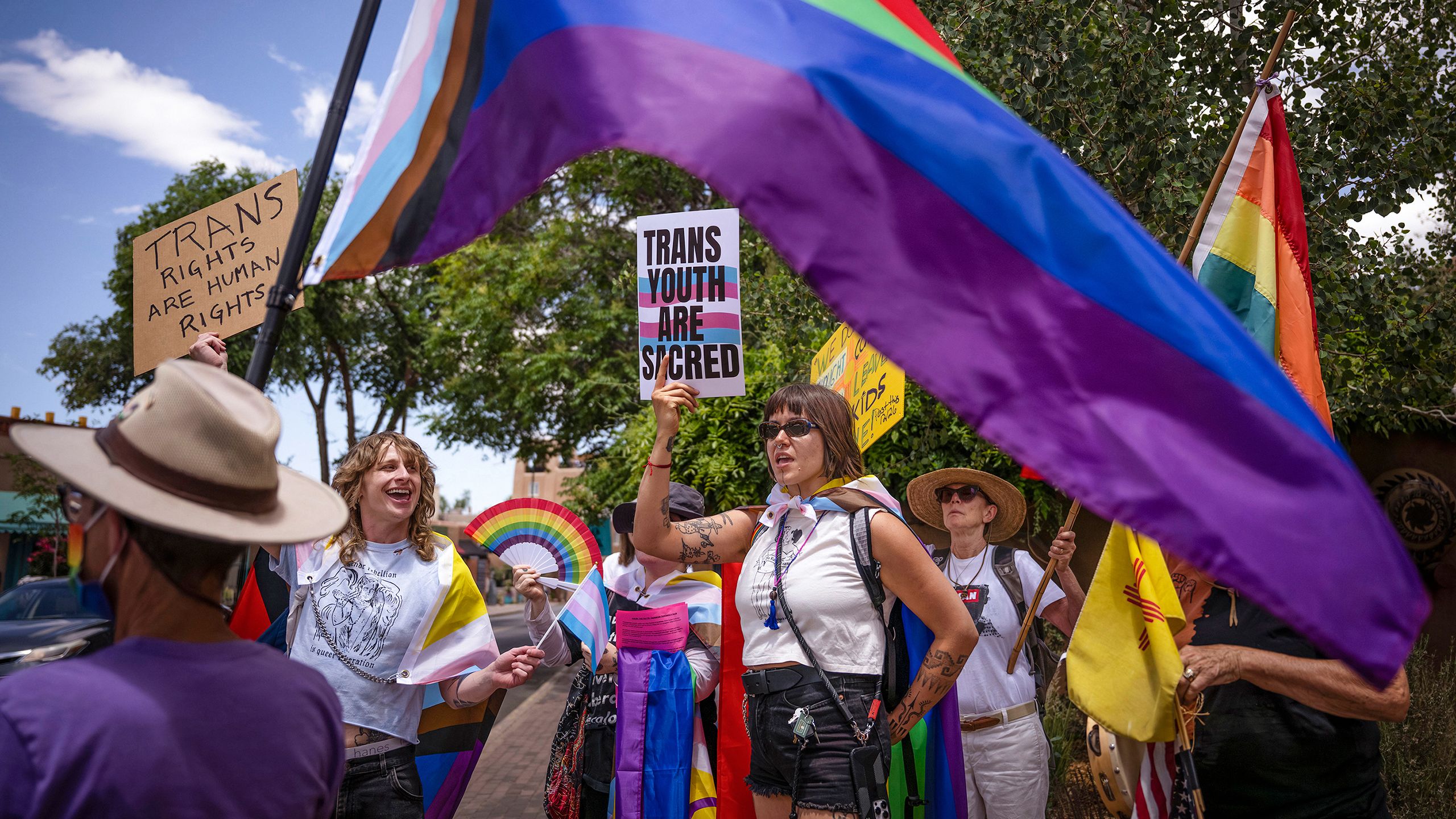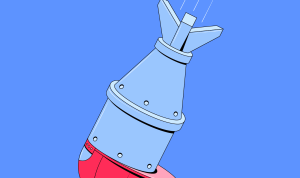With the “Big Beautiful Bill” in flux, and federal funds for gender-affirming care hanging in the balance, protections for trans children and adults continue to be dismantled at the state level.
This weekend, as raucous parties and strident Pride marches take place across New York City, many in the L.G.B.T.Q. community are in a less than celebratory mood. At best, the vibe is ambivalent, withlocal political victoriesovershadowed by ominous national news. Trans people, in particular, are grappling with the painful political disappointments of the past year. The Supreme Court, in its recent ruling in United States v. Skrmetti,upheld a Tennessee state lawbanning puberty blockers and hormone therapy for minors, and the Trump Administration is attempting to ban all pediatric gender-related care. Older trans individuals, too, are under threat, as the Administration now seeks to block federal funds from supporting trans health care. There are roughly two hundred and seventy-six thousand trans adults currently enrolled in Medicaid; their access to gender-affirming care may soon be stripped away, should Trump’s “Big Beautiful Bill” pass in the Senate. Hormones and surgery costs could soar beyond most trans people’s means, forcing some to resort to alternative methods, like using underground D.I.Y. networks, or seeking care abroad. Although the Administration, with its proposed changes to programs like Medicaid, may claim that its guiding principle is fiscal conservatism, its true goal is control.
In May, more than a month before the Supreme Court’s ruling in U.S. v. Skrmetti, the Department of Health and Human Services released a four-hundred-and-nine-page document casting doubt on the safety of gender-affirming care for children. The report attempts to undermine the idea that it is safe for trans children to receive hormone-replacement therapy and puberty blockers, the treatment course established by the World Professional Association for Transgender Health (WPATH), and which is currently endorsed by all major medical associations in the U.S. (Despite conservative fearmongering about young trans people undergoing radical medical procedures, theWPATHguidelines generally recommend that only those above the age of eighteen should receive genital reconstructive surgery.)
According to the H.H.S. report, for the vast majority of people, gender dysphoria is simply a temporary discomfort. Perhaps, with proper care, such as counselling, they would come to terms with the “reality” of their biological gender. The report begins with explanations of various medical maxims: one isPrimum non nocere—“First, do no harm.” But counselling can sometimes be a thinly veiled disguise for conversion therapy, and conversion therapy is harm at the highest level—I know this from experience. The report technically calls for “gender exploratory therapy,” noting that “being labeled a ‘conversion therapist’ ” is a “damaging accusation given the profession’s mistreatment of gay people.” But such a claim fails to acknowledge the possibility that gender-exploratory therapists may be perpetuating the same kind of mistreatment.
The H.H.S. report contradicts a previous assertion from the U.S. Substance Abuse and Mental Health Services Administration, a subset of H.H.S., which has written that no research has displayed convincing evidence that therapy can alter a patient’s gender or sexual identity. It also contradicts guidance from medical authorities such as the American Medical Association and the American Academy of Pediatrics, the latter of which hascalledthe H.H.S. report “inaccurate.” These authorities stand by the recommended treatment protocols established byWPATH, an organization of physicians, surgeons, and mental-health professionals that emerged from an attempt to standardize care in 1979. Trump has deridedWPATHfor conducting “junk science,” and the organization has been accused of selectively publishing research regarding the effectiveness of pediatric trans care on mental health. But the H.H.S. report, which Trump ordered as a corrective, does not represent a good-faith effort to engage on the question of when and how young people suffering from gender dysphoria should be treated. Rather, in its reliance “on select perspectives and a narrow set of data,” in the words of the American Academy of Pediatrics, it engages in the same kind of cherry-picking thatWPATHhas been accused of. After enacting a ban on pediatric trans care, in 2023, Utah lawmakers commissioned an assessment of the safety of puberty blockers and H.R.T. The study recently found that these treatments are both safe and effective. But, as Chase Strangio, a trans lawyer at the A.C.L.U.,pointed outin an Instagram video, the report got little mainstream-news coverage. The H.H.S., and the political right at large, have instead focussed on detransitioners. If trans people comprise a small community—an estimated 0.6 per cent of the population—then the detrans community is even smaller. Yet the right loves to platform their stories; the H.H.S. report describes these individuals as “brave whistleblowers.”
For trans children caught in these political crosswinds, the stakes are high. “Being called your correct name and pronouns, being on HRT, that can be the difference between life and death,” Zelda, a seventeen-year-old trans boy from Louisiana, recentlytoldtheCut. More than forty per cent of trans adults have attempted suicide, according to the Williams Institute at U.C.L.A. While the H.H.S. report does raise the alarm on trans suicide, at times it suggests the blame is on hormones, more so than a culture rife with violent transphobia. This is despite the fact that numerousreportshave found that those who undergo conversion therapy are far more likely to die by suicide than their peers. In states where anti-trans legislation passed, suicide attempts by trans teens subsequently went up by seventy-two per cent, according to the Trevor Project, a nonprofit organization focussed on crisis prevention for L.G.B.T.Q. youth. Some have argued that the studies have yet to directly link access to trans health care with lower youth-suicide rates, but medical care is not the only factor influencing mental health—discrimination, job security, stigma, and harassment also play key roles. Still, as Strangio, who represented the plaintiffs in the Skrmetti case, told the Supreme Court during oral arguments, “There are multiple studies, long-term, longitudinal studies that do show that there is a reduction in suicidality, which I think is a positive outcome to this treatment.”
Children are often caught at the center of the moral panic around transness. They are the testing ground for the erosion of trans rights, which conservatives often frame as a defense of parents’ rights. This thinking, too, is reflected in the way that the media often spotlights the voices of parents of trans kids rather than the children themselves. Right-wing stories that aim to whip up panic about an alleged “trans boom” tend to interview parents, infantilizing the kids as unreliable narrators. Even on the left, the voices of parents are often prioritized, ranging from spokesperson or advocate to the central narrator of their trans child’s story, in a way that goes beyond the standard journalistic practice of protecting minors, given that these trans kids are often in their teens. (A rare exception is “Just Kids”—a recent documentary directed by Gianna Toboni about the great lengths that trans kids must go to in order to receive care—which interviews a number of trans children and allows them to speak for themselves about the criminalization of their care.)
It is easy to deprive children of trans rights because our society generally functions as if children don’t have any rights at all. We struggle to believe that these little humans are capable of making their own decisions, much less of telling us who they are. But, although conservatives might focus their public messaging around trans children, it’s naïve to think that trans adults will be any safer from the Administration’s ire. The age at which someone should be “allowed” to transition keeps moving: Trump recently said nineteen; other conservative critics have suggested waiting until people are in their twenties. (Of course, this would mean that no one is allowed access to puberty blockers.) But the White House’s goal isn’t just no new trans kids; it’s no trans people, period. This is the clear takeaway from Trump’sexecutive order“Defending Women from Gender Ideology Extremism and Restoring Biological Truth to the Federal Government,” which declares that sex is immutable, and withdraws all federal recognition for trans people.
Trans kids are often used as a Trojan horse. An early version of the House Republicans’ “Big Beautiful Bill” proposed eliminating Medicaid funding for gender-affirming care solely for minors; a later version of the bill struck the phrase “for minors.” Curtailing care for trans adults was always part of the larger conservative plan. In addition to stripping away coverage for trans health care, the bill also sets stricter work requirements for Medicaid—another dangerous prospect for trans people, who face significantly higher unemployment rates. When I started transitioning, I was unemployed and reliant on Medicaid coverage. Many trans people have expressed outrage at the proposed bill: “Being covered by Medicaid has given me medical support I never thought possible,” the comedian Marley Gotterer told me. “ ‘Lifesaving’ doesn’t even come close to describing it.” Health care, she continued, “shouldn’t be about luck.”
In her recent book “Aggregated Discontent,” Harron Walker writes about Amida Care, a Medicaid health plan in New York specifically designed to help low-income trans people. “They paid for my hormones during two significant periods of my life when I couldn’t get insurance through work, because no employers with those kinds of jobs would hire me,” Walker told me over the phone. “It’s why so many of us don’t have to stress about paying for hormones every month, much less other bills, and why we’re able to focus on our art, our work, whatever else makes up our life—because we’re not funnelling all of our attention and resources into figuring out how to get health care.”
The Trump Administration is “using every mechanism at their disposal to try to decrease access,” Strangio, the A.C.L.U. lawyer, has said. He has suggested that, in order to build a “trans liberatory project,” the left must embrace a “politics of solidarity.” This is more than just a catchy slogan; the idea is a coalition focussed on securing material rights for the various groups struggling to safeguard bodily autonomy in our current moment—immigrants, women seeking abortions, disabled people. (As part of the “Big Beautiful Bill,” Republicans have also been seeking to deny Medicaid coverage for abortion and forDACArecipients.) Thesame executive ordermeant to strip government protections from trans people has recently been applied by the Department of Veterans Affairs in a way that affects a broad swath of cisgender individuals as well, owing to the removal of language that explicitly prohibits doctors from discriminating against patients for their marital status or political beliefs. “Under Trump’s new rules, veterans can be blocked from getting care, and doctors can be barred from working at V.A. hospitals for the sole reason that they may be unmarried, belong to a union, are registered Democrats, or identify as gay or trans,” Senator Patty Murray, the former chair of the Senate Veterans’ Affairs Committee, wrote in a statement.
“I want people to fight for others and others will fight for us,” Strangio said. Still, it is easy to feel pessimistic. While there are occasional victories—a federal district judge recently ruled against the Trump’s Administration’s anti-trans passport policies—it is hard to know whether the White House will comply, even when it loses in court. The “Big Beautiful Bill” may still be in flux, with federally funded trans health care hanging in the balance, but protections continue to be dismantled at the state level; there are two bills in Texas, for instance, that seek to prohibit trans health care and insurance protections, and which are already under way. Democrats, meanwhile, seem all too willing to compromise, having turned their attention to less “controversial” battles. Zohran Mamdani and Tim Walz are some of the rare politicians who have continued to champion gender-affirming care, whereas many other prominent members of their party, such as Gavin Newsom and Kamala Harris, have backed down on their previous support of trans issues. Trans participation in sports is often a particular point of contention on the left. Last year, Massachusetts representative Seth Moulton told theTimes: “I have two little girls. I don’t want them getting run over on a playing field by a male or formerly male athlete.” By shifting the conversation to sports, Democrats obscure larger issues like the assault on trans health care. Trans people are not just a cultural war issue. They deserve material rights.
I tried to talk myself out of transitioning. For years, I sat in an armchair across from a Christian counsellor to discuss “my situation.” It took a long time to undo the psychic damage, to learn how to inhabit my body, to not dissociate long enough to realize I wanted to change my sex. If we enforce the idea that changing gender is unthinkable, it soon begins to seem impossible. But we have the capacity to think such audacity into being. All change is dangerous, but to remain impermeable to new identities, and to new bodies, is a brittle way to live. We don’t need freedom from change, but freedomtochange.
Last September, I “got” a vaginoplasty. Though it was before Trump was reëlected, I was not the only one to joke that perhaps my procedure was among the last that this country would offer. What’s perhaps more noteworthy is how few of these surgeries occur, even in an environment that’s not openly hostile to trans people. In 2020, just over nine hundred vaginoplasties were performed in the U.S.,accordingto theJournal of the American Medical Association. The worldwide figure is around three thousand annually. (Phalloplasties are even rarer; only about three per cent of trans men have received such a surgery.) For the past few years, right-wing politicians and pundits have written about trans surgeries as if they are offered for free at drive-ins. The numbers tell a different story.
A larger number of trans people utilize hormones, which are life-altering but not as drastic as surgical intervention. When I go to get my hormone-replacement-therapy (H.R.T.) prescription, I sit in a waiting room next to post-menopausal women seeking the same medication. Many cis women also take spironolactone, the foul-smelling little pills that I once took as a part of H.R.T., in order to get rid of their acne. Trans people, often forced to do their own research, are more likely to understand the risks, side effects, and joys of estrogen and testosterone. Cis people, on the other hand, usually trust their doctors implicitly in regard to these medications because they’ve typically been able to.
The regret rate for kids who transition is far lower than Republican lawmakers would like us to believe, not even rising above one per cent, according to a 2021 collection of studies published in Plastic and Reconstructive Surgery Global Open. Kristina Olson, the lead author of a 2024 JAMA Pediatrics study, told NPR that only four per cent of participants expressed regret with some aspect of their care: “Often the regrets they were expressing had to do with [wishing] they hadn’t done blockers and they’d gone straight to hormones, or they maybe had a negative side effect related to the blockers,” such as an implant getting irritated. Regret is a phantom frequently leveraged against trans people, especially children.
Republicans claim they are protecting children, in particular, from making choices that the kids will later wish they could undo, the kind that will scar them and limit their ability to have fulfilling, reproductively healthy lives. It’s a modern twist on an age-old fear. In his book “Kids These Days” (2017), Malcolm Harris chronicles parents’ growing intolerance for risk, often because they see their children as an economic investment. Harris cites an article in theAmerican Journal of Playby Peter Gray, about adolescents’ declining ability to self-direct their leisure time:
Even casual observations of children playing outdoors confirm that these youngsters, like other young mammals, deliberately put themselves into moderately fear-inducing conditions in play. . . . If too little fear is induced, the activity is boring; if too much is induced, it becomes no longer play but terror. Nobody but the child himself or herself knows the right dose, which is why all such play must be self-directed and self-controlled.
The task, for all of us, is to become autonomous, capable of managing our own lives—understanding work and play, danger and reward, fantasy and reality. Trans people are all too aware of such dichotomies. Happiness is never far from risk. But some things are perhaps worth doing even if they do not come with a guarantee. ♦









